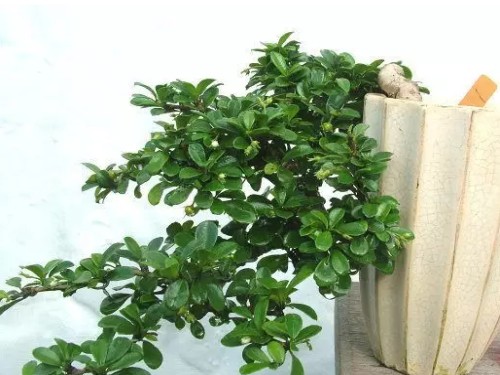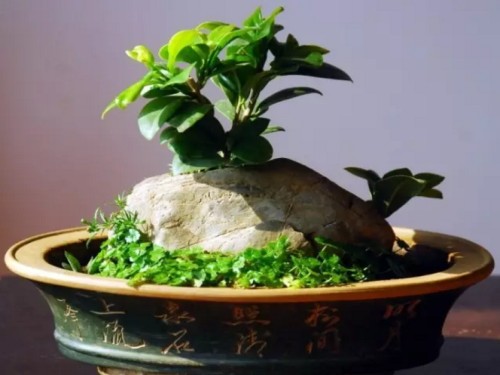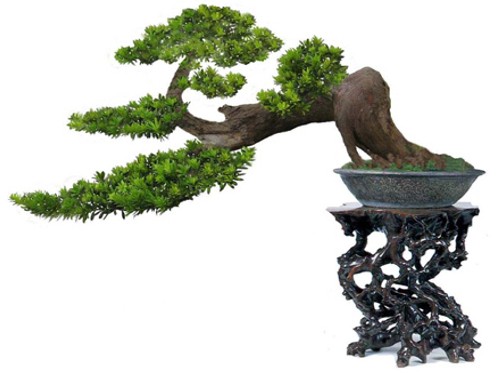How to lose the leaves of Fujian teapot scenery?
Fujian tea, also known as base tree and cat tree, is an evergreen shrub of Arnebiaceae. The leaves are small, long oval, dark green and shiny. White florets bloom in spring and summer, drupe globose, red after green. With its rugged trunk, colorful Qiu qu and elegant tree posture, it is not only one of the four major bonsai tree species in Lingnan, but also five species exported to the United States after China's entry into WTO. Fujian tea is a southern tree species, which is afraid of cold. Pot culture in the Yangtze River basin and its northern area must be placed in a ventilated and transparent place with moist air. Must be put into the greenhouse in winter, the temperature had better not be less than 10 ℃, and maintain a certain humidity. Summer is kept in the shade.

Ornamental Fujian tea tree shape is short, dense branches, green leaves and white flowers, leaves and fruits red, strange appearance. The bonsai bred by the old tree stump is more quaint. It is suitable to watch all the four seasons, especially when the young leaves are fresh in summer. However, in our daily maintenance, we often encounter the phenomenon of losing leaves in Fujian teapot scenery. So, in view of the phenomenon of losing leaves in Fujian teapot scenery, what should we pay attention to in daily maintenance? To put it simply, conservation should pay special attention to light, temperature, water, fertilizer, flowers and insects.
Light: too much sunlight has two side effects: first, it is easy to cause leaf dehydration and shedding; second, too much pigment deposition is "dark green" rather than "new green", affecting the ornamental effect.
Temperature: Fujian tea bonsai is very sensitive to low temperature. The temperature stops growing below 15 ℃ and dies below 5 ℃. Therefore, before entering winter, Fujian tea must be moved indoors in time for overwintering. If there is no indoor heating equipment, we must try to raise the room temperature to more than 5 ℃.
Water: Fujian tea bonsai is a southern tree species, especially in summer, as long as the topsoil is observed to be dry with the naked eye, it should be watered in time. The leaves of Fujian tea bonsai are easily dehydrated, and only new leaves sprout at the turn of spring and summer in a year, so ensuring sufficient moisture is the most basic and key factor to maintain Fujian tea well.
Fertilizer: Fujian tea bonsai like fertilizer is another feature of it, especially in the spring and summer growing season, thin fertilizer should be applied frequently. Lack of fertilizer will lead to thin leaves and light color, which will directly affect the ornamental effect. Due to the well-developed root system of Fujian tea bonsai, topdressing can not fully meet the needs, so the pot should be changed in time according to the specific situation, and sufficient base fertilizer should be applied when changing the pot. Fujian tea bonsai does not require high light, and the scattered light is enough to meet its growth needs.
Flowers: Fujian tea is an ornamental plant, its many and small white flowers not only have no ornamental value, but consume a lot of nutrients and affect the growth of the leaves, and the declining flower stems mixed in the leaves will also greatly affect the ornamental effect, so, the only way to solve this contradiction is to remove the buds in time.
Insects: Fujian tea rarely occurs diseases and insect pests, but aphids are easy to breed in spring and summer when new leaves sprout every year. Aphids are basically harmless to old leaves, but because Fujian tea only germinates one season of new leaves every year, once it causes harm, it will affect for a year, so special attention should be paid to the control of aphids before and after sprouting new leaves every year.
In addition, Fujian tea bonsai often lose leaves, which is estimated to be due to increased moisture in the maintenance process, and another reason is that it may be caused by lack of light and other reasons. It is suggested that bonsai friends should give your bonsai tea trees more natural sunshine time while keeping the temperature between 20 and 25 degrees Celsius, and add some base fertilizer to your bonsai tea trees to provide them with nutrients in spring. In this way, your bonsai tree will flourish again!
Time: 2019-06-01 Click:
- Prev

Why did the banyan bonsai lose its leaves? What if the leaves of the banyan bonsai fall?
Banyan bonsai is one of our most common bonsai. It is evergreen, graceful and easy to maintain. After years of conservation of banyan bonsai, I feel that its more common problem is falling in love with leaves. Once her daughter put one of the banyan bonsai into her room, which had only been in the room for two days.
- Next

Maintenance method of bonsai of Luohan pine
The bonsai trees of Luohan pine are lush and elegant, ancient and vigorous, with bright green leaves all the year round, with a sense of vitality and nobility. If attached to the rock, made into the posture of eagle claw holding stone, more quaint and chic. Luo Hansong and bamboo, stone group scenery, extremely elegant. Jungle style Luohan pine bonsai, coupled with grazing scenery, can give people a wild enjoyment.
Related
- Fuxing push coffee new agricultural production and marketing class: lack of small-scale processing plants
- Jujube rice field leisure farm deep ploughing Yilan for five years to create a space for organic food and play
- Nongyu Farm-A trial of organic papaya for brave women with advanced technology
- Four points for attention in the prevention and control of diseases and insect pests of edible fungi
- How to add nutrient solution to Edible Fungi
- Is there any good way to control edible fungus mites?
- Open Inoculation Technology of Edible Fungi
- Is there any clever way to use fertilizer for edible fungus in winter?
- What agents are used to kill the pathogens of edible fungi in the mushroom shed?
- Rapid drying of Edible Fungi

